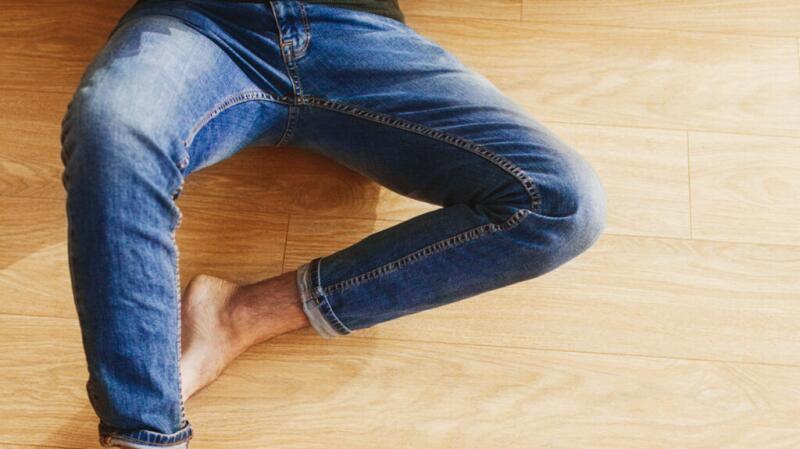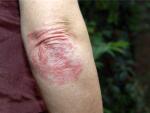What causes groin rash?

There are many possible causes of a rash in your groin. It can be the result of something simple like heat and sweat, or something more complicated like bacteria or a parasite. Many causes of groin rash are treatable, and some are even preventable.
Jock itch
Jock itch is a fungal infection due to a fungus commonly found in gyms and locker rooms. It typically appears in your groin area. However, you can also find it in other areas like:
- upper thighs
- scrotum
- penis
- anus
Jock itch is not serious. The itching it causes can become very uncomfortable and even painful, however.
The symptom of jock itch is a rash that involves:
- itchiness
- raised and scaly edges
- redness or discoloration
- areas of oozing
- reddish-brown center
Jock itch is due to exposure to a fungus. This can happen through:
- skin-to-skin contact
- infected clothing
- damp towels
- public shower facilities
- locker rooms
Molluscum contagiosum
Molluscum contagiosum is an infection resulting from a type of pox virus. This infection typically causes a mild, benign skin condition. It appears as lesions anywhere on your body, including:
- genital area
- face
- neck
- arms
- legs
- abdomen
Molluscum contagiosum typically clears on its own within
The lesions from molluscum contagiosum typically look:
- small and raised
- white, pink, or skin-colored
- dimply or pitted in the middle
- pearly
- smooth and firm
These lesions may also become:
- itchy
- red or discolored
- swollen
- sore
Heat rash
Heat rash is a common and harmless rash. It is typically very itchy. Heat rash appears in areas that tend to collect moisture when you sweat, such as:
- groin
- underarm
- under the breasts
- chest
- back
- elbow creases
- behind the knee
- waist
Heat rash is more common when you sweat more, such as in the summer or in hotter climates.
The symptoms of heat rash typically last from 2–3 days, and include:
- small red or discolored spots, or clear blisters
- itchiness
- sensation of prickliness
- redness or discoloration
- swollen areas
Intertrigo
Intertrigo is a rash that typically appears in the folds of your skin. It is common in areas where the skin rubs together and holds moisture.
Intertrigo is most common in people who have:
- overweight
- diabetes
- weakened immune systems
- decreased mobility
- bowel or bladder incontinence
Intertrigo rash typically appears red, reddish-brown, or discolored. It may itch or burn. In some cases, the rash can ooze and have a foul smell. It may also crack and bleed, depending on the area it is in. While intertrigo can appear anywhere on your body, it is most common in these areas:
- groin
- armpits
- underneath breasts or belly
- creases of the neck
- between the buttocks
Learn more about skin conditions here.
Erythrasma
Erythrasma is a common skin condition that typically affects the folds of the skin. The most common areas to find it are:
- groin
- armpits
- between the toes
Erythrasma is the result of a bacteria called Corynebacterium minutissimum. It can affect anyone. However, it tends to occur more frequently in People of Color or when people experience:
- warmer climates
- excessive sweating
- diabetes
- obesity
- difficulty with hygiene habits
- older adulthood
- weakened immune systems
The rash associated with erythrasma typically presents with:
- pink, brown, or discolored patches that are well-defined
- fine scaling
- superficial fissures
- itchiness
Other causes of groin rash
There are various other reasons you may develop a groin rash. These other causes include:
- hair removal
- allergic reaction or contact dermatitis
- lichen planus
- lice or scabies
- certain sexually transmitted infections (STIs) like:
How do you treat groin rash?
Treatment for groin rash depends on the underlying cause of it. Some common treatments for causes of groin rash include:
- antibiotics, both oral and topical
- antiseptic cream
- emollient moisturizers
- antifungal cream
- steroid creams
Some causes of groin rash are self-limiting and do not require treatment. If you notice a rash in your groin area, contact your doctor so they can diagnose the cause and recommend the most effective treatment.
Read about when to see a doctor for a rash.
How can I prevent groin rash?
Many of the causes of groin rash are preventable. To help prevent groin rash, try these tips:
- Only use mild soaps.
- Avoid using products with fragrance.
- Change your underwear daily.
- Wear clean clothes and remove wet clothes right away.
- Maintain a moderate weight.
- Practice proper hygiene habits.
- Avoid sharing gym clothes, equipment, or towels.
- Use a condom or another barrier method when you have sex to prevent STIs.
Summary
There are many possible causes of a rash in your groin area. Most of these causes are treatable, and many are preventable.
If you develop a new and unexpected rash in your groin, contact your doctor. You might be able to treat it with over-the-counter products. However, it is important for your doctor to diagnose the underlying cause of the rash to recommend the most effective treatment.
With any kind of rash, avoid scratching it as this can lead to infection. If you notice symptoms of infection like pus, skin feeling hot to the touch, and inflammation in the area, contact your doctor right away.





















